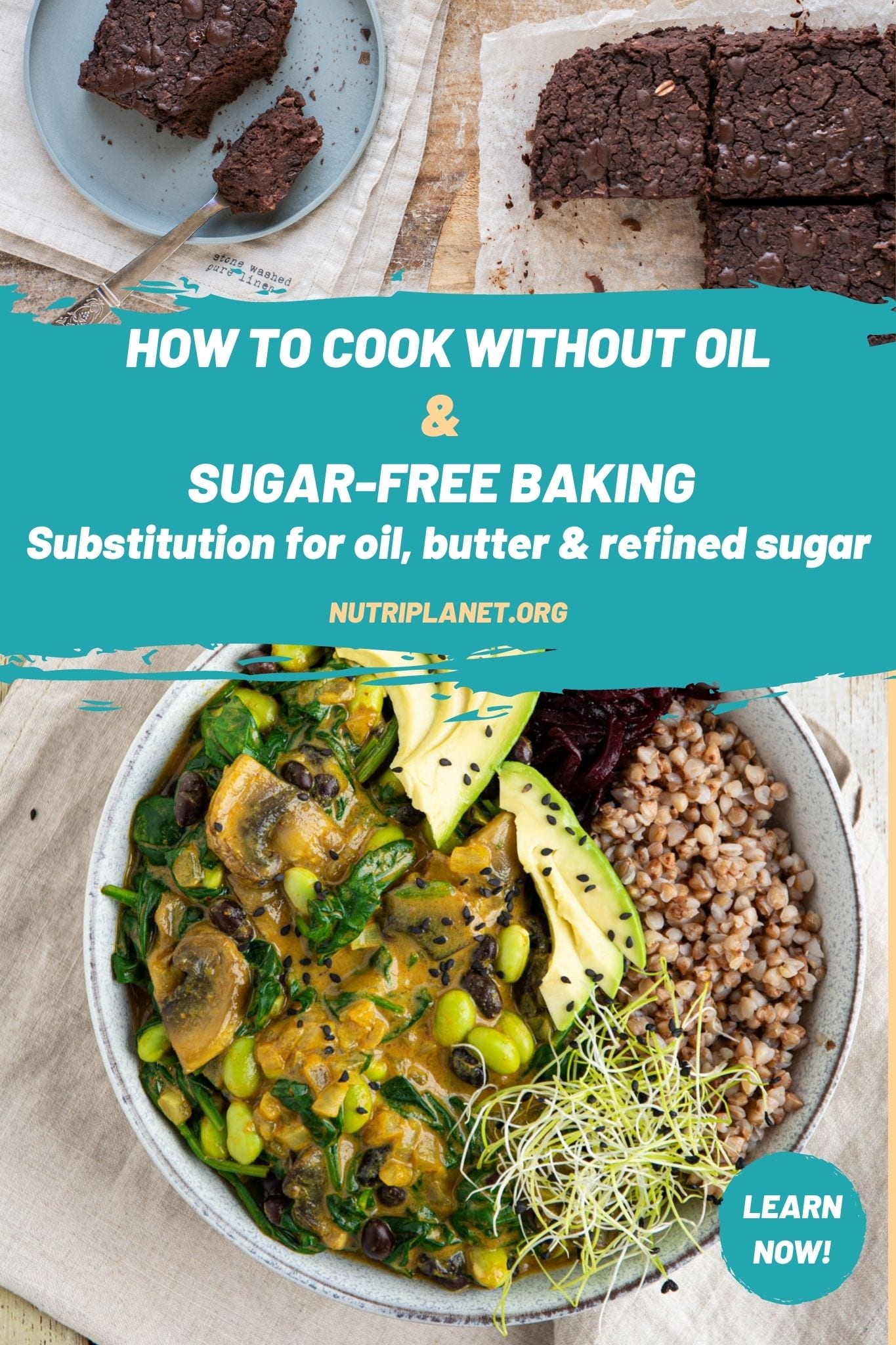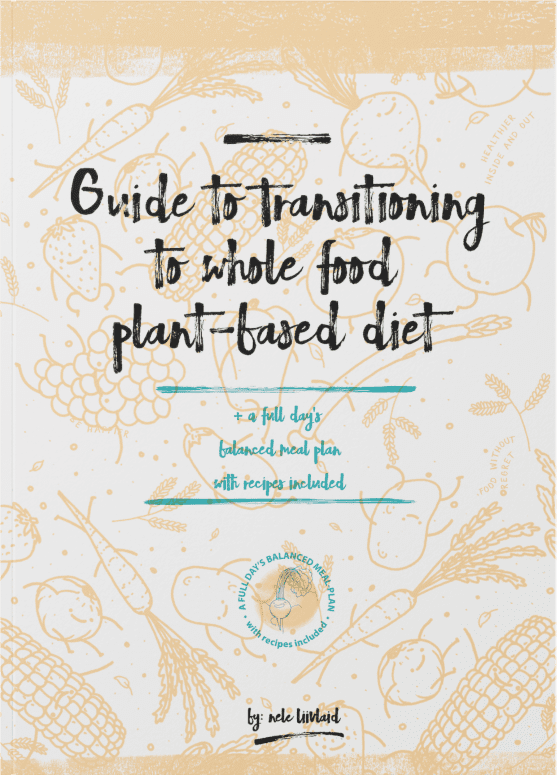Learn how to cook without oil and get to know the secrets of sugar-free baking. What are the best substitutions for oil, butter and refined sugar in baking, salad dressings, desserts and smoothies?
When I started cooking without oil and sugar I was amazed of how rich and satisfying the food tasted. To be clear, I had no problems with replacing sugar as there are so many great substitutes. Besides, I have never liked overly sweet things anyway.
I hope that following the below simple tips for cooking without oil and sugar will make your transition easier.
How to Cook Without Oil
Plant-based whole food substitutions for butter and oil
Oil-free baked goods:
- Boiled and pureed fruits and sweet vegetables (e.g. applesauce, prune puree or pear sauce, pureed pumpkin or summer squash) act as a binder and make your cakes and muffins moist.
- Pureed raw fruits (persimmon, mango, pineapple, banana) make your baked goodies moist too, but also act as a sweetener.
- Nut and seed butters (peanut butter, tahini or sesame seed paste, cashew paste etc.) work in baked items such as cakes, cookies and muffins. If you don’t have nut or seed butter on hand, add soaked nuts to the wet mixture.
- Beans – ideal for baking brownies. Beans make them moist and give mass.
I usually use about 2 tablespoons of nut butter along with a combination of bananas, other sweet fruits or applesauce for a lower fat sweet treat.
See recipes for Bean Brownie, Poppy Seed Muffins, Chocolaty Peanut Butter-Persimmon Muffins.
Oil-free salad dressings and sauces:
- Nut and seeds butters: just add some water, lemon juice and seasonings to ½ tsp of nut butter, mix it well and pour over your salad.
- vinegar (if you can tolerate it) + water + herbs
- avocado with water, lemon, a bit of sweetener, sea salt, fresh basil
- water + herbs + thickener
- mustard + water
- vegetable purees
- pureed boiled beans. See recipe for White Bean Dressing.
- just add some nuts, seeds and avocado to your salad. Nuts: walnuts, almonds, pecans, hazelnuts. Seeds: sesame, sunflower, pumpkin, hemp, flax)
In this delicious Veggie-Chickpea Stew I used a peanut butter and soy milk sauce which turned out wonderful.
Cashew sour cream/mayonnaise can also be used as a dressing or a sauce.
Sautéing and stir-frying without oil
It’s easy to use water, stock or even white wine for frying and stir-frying.
Add 2 tbsp water in a large skillet. Once the water starts to sizzle, add onion or whatever vegetables you want to fry. Sauté them, stirring occasionally and adding water one tablespoon at a time to prevent sticking. Cover the skillet with a lid to make the veggies cook faster.
How to Make Sugar-Free Recipes
By all means, you don’t have to forgo sweetness as a plant-based whole foods eater. Fortunately there are some excellent alternatives to plain white sugar.
Sugar-free baking, smoothies, oatmeal, or pancake jam
- Chop dried fruits (date or other dried fruit paste), add enough water to cover and let soak for 30 minutes. Blend until smooth (use a regular blender or immerse blender). Use boiled water. If you don’t consume the whole batch at once you can store it in the fridge.
- Sweet fruits (persimmon, mango, banana, pineapple). Puree and use as jam or as a sweeter to moisten muffins or cakes.
To be honest, with conventional cake, cookie or muffin recipes, it’s actually difficult to replace the sugar. It’s because the quantities of the other ingredients will need to be adjusted too if you use date paste or sweet fruits instead of dry white sugar.
However, I have recipes for you to follow that use whole food ingredients. For example, see recipes for Bean Brownie, Poppy Seed Muffins, Chocolaty Peanut Butter-Persimmon Muffins.
Replacing sugar in hot beverages
The goal is to train your palate so you don’t need anything extra in your coffee or tea. To start re-training your taste buds, cut down on the amount of sugar in your morning cup of coffee and replace it with a healthier alternative:
Xylitol
Xylitol is a naturally occurring alcohol found in most plant material, including many fruits and vegetables. It’s extracted from birch wood or corn. Xylitol is widely used as a sugar substitute in “sugar-free” chewing gums, mints, and other candies.
Xylitol tastes sweet but, unlike sugar, it’s not converted in the mouth to acids that cause tooth decay. It reduces levels of decay-causing bacteria in saliva and also acts against some bacteria that cause ear infections.
Adults should avoid higher doses of over 50g per day and for children it’s 20g per day. Pregnant and breast-feeding women should stay on the safe side and avoid xylitol as not enough is known about it when it comes to expectant and new mothers. (1)
Xylitol is expensive, but as your palate adjusts you’ll only use a teaspoon every now and then. I bought a half a kilo package and after a year, I hadn’t even consumed a quarter of it.
Don’t use xylitol in baked goods that use active yeast or in fermented products.
Raw cane sugar
It’s still sugar, but in a more natural form and suitable for a gradual transition towards sugarless beverages.
Palm Sugar
Palm sugar is often labelled under various other names reflecting the several different species of palm used and its wide production area across Africa and Asia. Palm sugar was originally made from the sap of the Palmyra palm, the date palm or the sugar date palm. Now it’s also made from the sap of the Arenga pinnata (sugar palm) and the nipa palm, and may therefore be sold as “arenga sugar”.
Palm sugar is produced by tapping the sap from tree and boiling it down to produce a syrup. The syrup is then sold as is or allowed to crystallize into various shapes and sizes. (2)
Jaggery
Jaggery is a concentrated product of date, cane juice, or palm sap (see palm sugar) without separation of the molasses and crystals, and can vary from golden brown to dark brown in colour. (3) It’s available in health and organic stores.
Stevia
Stevia is about 100 to 300 times sweeter than sugar, but has no carbohydrates, calories or artificial ingredients. It has a peculiar taste though: a bit like menthol. You have to try it to see whether you like it.
Stevia is sold in powder or liquid form. Check the package before you measure out the sweetener as each brand has its own sugar-to-stevia ratio.
The U.S. Food and Drug Administration(FDA)approved only the purified form of stevia, called stevioside, as safe to use. If you see whole stevia leaves or crude stevia extracts at your local natural foods store, don’t buy them. (4)
Agave nectar
Agave nectar is extracted from the agave plant, a plant that is used to make tequila. It’s a lot sweeter than sugar so use half as much. Agave nectar is usually found in health stores.
I don’t recommend using a lot of agave every day because it’s high in fructose. It’s fine if you only put a bit in your coffee.
Read on low glycemic sweeteners from my post Low Glycemic Sweeteners. And watch this video as well:
The bottom line is that artificial sweeteners aren’t a substitute for healthy eating, but they can help you on your way to a better diet.
When consuming sweeteners, always be aware of the QUANTITIES. A little bit of artificial sweetener won’t harm you but a lot just might…no matter how healthy the package says it is for you.

This post is also available in: Spanish











